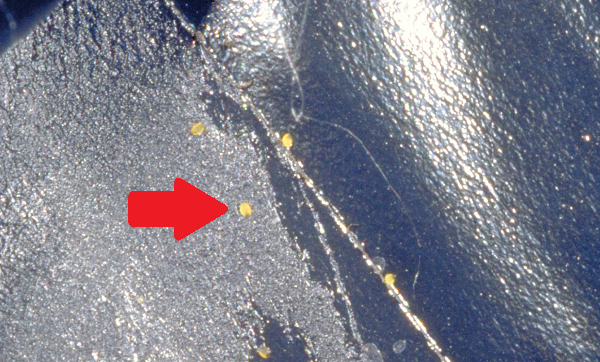San Jose Scale
ENTFACT-204: San Jose Scale | Download PDF
by Ric Bessin, Extension Specialist
University of Kentucky College of Agriculture
San Jose scale is an extremely important indirect pest of apples, pears, peaches, and plums. It is a sucking insect that injects a toxin into the plant as it feeds causing localized discolorations. The presence of reddish blemishes on fruit at harvest indicates potentially damaging numbers on the trees. Left uncontrolled, San Jose scale can kill limbs or even the entire tree in just a few years.
San Jose scale overwinter as immobile immature scales on the tree. In the spring, the tiny winged males emerge and mate with the wingless females, and about one month after the start of the male flight, the first crawlers can be seen. Eggs are not seen because females give birth to live crawlers. These tiny yellow insects move around randomly on bark and foliage before settling down permanently.

Figure 1. San Jose scale crawlers stuck to electrical tape on an apple limb.
A few days after settling down, crawlers will secrete a waxy covering over their body that will protect them from pesticides. From this point on female scales will not move. Males will remain in one location until maturity, at which time they emerge as winged adults to seek out females and the cycle begins again.

Figure 2. Bark pealed back to show San Jose scale injury to new wood.
San Jose scale injects a toxin which is damaging to the tree. If bark is pealed back underneath active infestations, the tissue which should be light green will have a scarlet appearance. This may also be seen on fruit at harvest being very noticeable on green varieties. When such damage is noted, inspect trees for scale, especially one year-old wood. Purplish-red halos on young bark are indications of scale infestation. Often this very small insect goes unnoticed until large populations have developed.
Pheromone Trapping and Degree Day Accumulation
Pheromone trapping involves the use of chemical lures to attract male scales. These chemical lures are synthetic copies of the chemicals female scale use to attract the male for mating. Commercial traps and lures are available to monitor San Jose scale activity. A hand lens is needed to see the crawler and adult stages. Pheromone traps for this insect should be placed in scale infested trees either prior to or during bloom. Lures should be replaced monthly. Male scales are extremely small gnat-like insects, so traps need to examined carefully. Scales appear as a fine dust on the trap, usually concentrated on the sticky surface near the pheromone lure. Trapping of scale is used to indicate when the activity of the male scales begins. The date that the first males are caught in the trap is termed the biofix date. Male flight usually occurs after petal fall (mid to late April). Pheromone traps need to be examined daily in order to known when biofix occurs. After the biofix has occurred, degree days are calculated on a daily basis and a running total kept (see "Predicting Insect Development Using Degree Days" in EntFact 201, Controlling Apple Pests). San Jose scale has a 51 degree F threshold temperature. These degree day accumulations are compared with the target values in the following table.

Detecting Crawler Movement
Crawler movement begins sometime between mid-May and mid-June. Dark double-sided sticky tape should be used to monitor for emerging crawlers. A small amount of tape is applied tightly around a scaffold limb after removing surface debris with sandpaper. A limb with a known infestation should be selected. Crawlers will appear as extremely small flattened yellowish insects which can be seen with a hand lens on the tape (especially around the edges). Within two days, the crawlers will find a permanent resting spot where they will feed and begin to secrete a protective waxy covering. There are two generations each year.
Effective control of San Jose scale in apples is obtained with dormant oil sprays. Insecticide sprays either target the immature scales at the half inch green stage of bud development or a late spring insecticide spray aimed at the immature crawler stage. Sprays directed against crawlers also protect fruit from infestation. This spray should be timed about one week after the first crawlers are seen. Applications aimed at the crawlers have little effect on the adult scales. Because San Jose scale occur on all parts of the tree, spray coverage as well as timing are very critical to effective control. Although there is a second generation later in the summer, crawlers emerge over an extended period of time making insecticidal control of this generation impractical.
For more information on reduced insecticide apple management programs, see ENTFact 201, Controlling Apple Pests.
Revised: 11/19
CAUTION! Pesticide recommendations in this publication are registered for use in Kentucky, USA ONLY! The use of some products may not be legal in your state or country. Please check with your local county agent or regulatory official before using any pesticide mentioned in this publication.
Of course, ALWAYS READ AND FOLLOW LABEL DIRECTIONS FOR SAFE USE OF ANY PESTICIDE!
Photos: Ric Bessin, University of Kentucky Entomology
